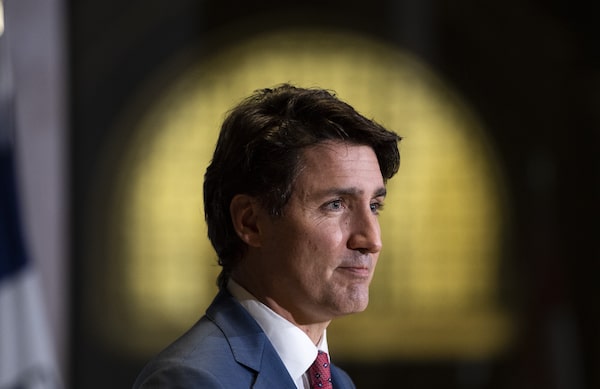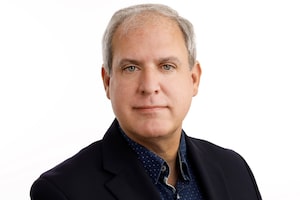
Prime Minister Justin Trudeau participates in an announcement on early learning and child care in the Northwest Territories, in Ottawa, on Dec. 15.Justin Tang/The Canadian Press
There is always more work to do, Prime Minister Justin Trudeau likes to say. And every year, there are unexpected events and new programs. And then there’s another pile of things, the decisions left over from last year, or the year before, or the year before that.
After six years, Mr. Trudeau could do with a resolution to clear some of the clutter off his desk by making the decisions he’s been dodging for a while.
We’re not talking here about the promises that were broken and consigned to the trash heap, like the pledge to reform the first-past-the-post electoral system that Mr. Trudeau jettisoned after a year in office, or those they have worked on but not fulfilled, like the commitment to end all boil-water advisories in First Nation communities by March, 2021.
These are the decisions in limbo – the things Mr. Trudeau kept putting off. Here are four things that have lingered on Mr. Trudeau’s To Do list.
Fighter jets
The decision on Canada’s next fleet of fighter jets has been an exercise of procrastination on top of obfuscation on top of procrastination.
Six years ago Mr. Trudeau came to power promising a competitive process that would somehow not choose the Lockheed Martin F-35. But the federal government has yet to complete the process, and when it is done, it will probably choose the F-35. That’s something Mr. Trudeau doesn’t want to announce.
The stalling on fighter jets started before Mr. Trudeau, during the tenure of Stephen Harper’s Conservatives, who announced in 2010 that Canada would buy a fleet of 65 F-35s. When it turned out to be politically controversial, Mr. Harper backpedaled and waffled till the 2015 election.
The plane was developed by the U.S. with a consortium of allies, so Canada never held a bidding competition to choose it. And the cost estimates ballooned: the government initially said the fleet would cost $16-billion to purchase and maintain, but the Auditor-General put the figure at $45-billion. There were quibbles about the plane’s single jet and development glitches. The Liberals opposed it.
Once in power, the Liberal government stalled too, ordering 24 second-hand CF-18s, before launching a new, lengthy competition. That’s winding down, and the old fleet can’t be extended forever. Mr. Trudeau has to face up to a decision on a new fighter.
Huawei and 5G
At the Liberal government’s cabinet retreat nearly three years ago, then-public safety minister Ralph Goodale insisted tensions with China and Beijing’s detention of two Canadians would not deter the government from making a decision on banning equipment made by Chinese telecom giant Huawei Technologies Co. Ltd. from Canada’s 5G networks.
Now Mr. Goodale is in London as Canada’s High Commissioner to Great Britain, having lost his seat in the Commons two elections ago. At this point, we can safely conclude the government has been deterred from making a decision.
China detained the two Canadians, Michael Kovrig and Michael Spavor, in transparent retaliation for the December, 2018, arrest in Canada of Huawei chief financial officer Meng Wanzhou under a request from U.S. prosecutors. But Ms. Meng cut a deal in September, and the two Michaels are home. And still, there’s no announcement on Huawei and 5G.
It is hard to imagine that Canada won’t restrict the deployment of Huawei 5G equipment. The U.S. warns it poses a security risk. Allies in the Five Eyes intelligence all apply a 10-foot-pole to the Chinese gear, and expect Canada to do the same. Of course, it will upset China. China’s ambassador, Cong Peiwu, has warned that a ban would send the “wrong signal.” But it’s time for Mr. Trudeau to lift radio silence on Huawei.
24 Sussex Drive
You might remember that address as the place where prime ministers used to live. Justin Trudeau lived there as a kid, but didn’t take up residence when he became Prime Minister because the place was falling apart. Six years later, it is still falling apart, and nothing has been done.
It isn’t likely to ever be the residence of this Prime Minister, who has instead commandeered Rideau Cottage, the official residence of the Secretary to the Governor-General. But that’s all the more reason that Mr. Trudeau should make a decision about 24 Sussex: He and his family won’t benefit.
The cost, and the political blowback from it, scares away politicians. Prime ministers have been afraid to spend on the residence for fear it will make them look like elites living high off the public dime.
It gets worse because the agency responsible for official residences., the National Capital Commission, has provided an estimate that seems like a gold-plated sum: $36-million, to bring the house back to its original condition.
That price tag is even before RCMP security improvements, according to the NCC. The agency says it is not just a house but a complex workplace with staff and police details, and its renovations have to be handled by relatively expensive, security-cleared heritage-building experts.
So 24 Sussex is in a stalemate: The NCC won’t fix it until they get money, and politicians won’t devote the money.
But it is time for Justin Trudeau to make a call. If he wants Canada to be the only G7 country whose head of government doesn’t have an official residence, he should say so. Or he can demand a cheaper estimate, if he chooses – heck, he can fire the NCC. Or he can give the renovations the go-ahead. Six years is more than enough time to decide.
High-frequency rail
Here’s one of those things the government seems to be deciding all the time, without ever deciding.
The Liberal government keeps making approving noises about high-frequency rail, but it still needs to make a go or no-go decision on the multibillion-dollar project to build new tracks for the Quebec City-Windsor corridor, at a cost of $4-billion to $6-billion.
That would be a strategic decision about the future of passenger rail, which comes second to freight service when it comes to deciding who gets to use railway tracks.
Via Rail has been backing the idea for years, but Justin Trudeau’s Liberals – and before them, Stephen Harper’s Conservatives – have been unwilling to set a direction for passenger rail. In 2016, when Mr. Trudeau’s Liberals had been in power for just months, then-auditor general Michael Ferguson complained in a report that the federal government had repeatedly ignored Via’s efforts to set a long-term strategic direction.
Since then, the Liberals have talked a lot about high-frequency rail. There has been planning and preprocurement spending. The government has repeatedly promised to launch a procurement process, but hasn’t yet. And what is still needed is the big yes-or-no commitment.
For subscribers only: Get exclusive political news and analysis by signing up for the Politics Briefing.
 Campbell Clark
Campbell Clark